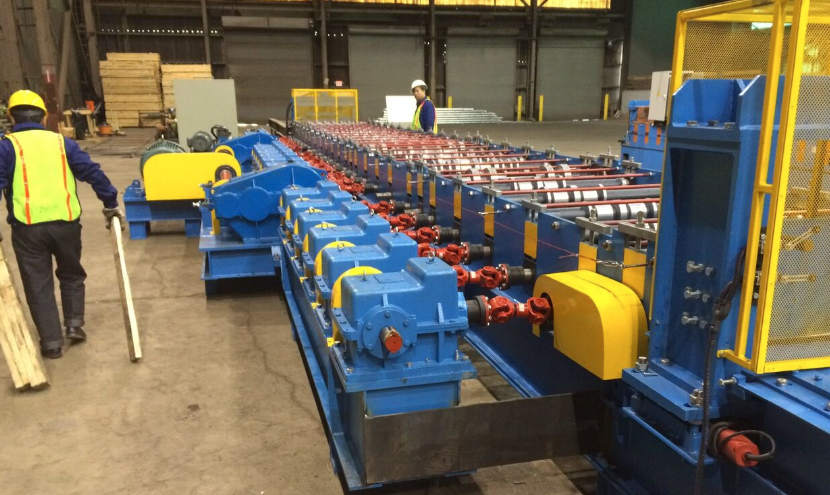
Posted on Wednesday, September 17, 2025
Installing a roll forming machine is not just about unboxing and plugging it in. These heavy-duty industrial roll formers are precision systems that require careful assembly, alignment, and setup to operate safely and efficiently. Whether you’re bringing a new roll forming machine into your facility or relocating an existing one, understanding the trades involved is crucial for a smooth machine installation.
In this guide, we’ll break down the key trades you need to install a roll forming machine, what each trade does, and practical tips for a successful setup.
Millwrights or mechanical fitters are essential for the mechanical installation of a roll forming machine. Their tasks include:
Leveling and anchoring the machine on a stable foundation.
Installing rollers, shafts, gearboxes, and drive systems.
Ensuring precise alignment to prevent issues such as twisted or bowed profiles.
Conducting initial mechanical checks before power is applied.
Without proper alignment, even a high-end roll forming machine will produce inconsistent parts and experience increased wear.
Most roll forming machines run on 3-phase power, making an industrial electrician indispensable. Their responsibilities include:
Connecting the machine to the correct voltage and phase.
Wiring motors, drives, PLCs, and safety circuits.
Ensuring proper grounding, overload protection, and emergency stop functionality.
An experienced electrician prevents costly mistakes and ensures the roll former operates safely and efficiently.
Hydraulic systems are common in roll formers with punching, shearing, or pressing functions. A hydraulic technician:
Installs and connects pumps, hoses, and cylinders.
Sets correct pressure and flow rates.
Tests the hydraulic system for leaks and smooth operation.
Proper hydraulic setup is essential for precision cutting and forming operations.
Some roll forming machines use air-operated systems for punching, cutting, or stacking. Pneumatic technicians:
Install compressed air lines and fittings.
Set up filters, regulators, and lubricators.
Test air-operated functions for timing and force.
Correct pneumatic installation ensures consistent performance and reduces downtime caused by leaks or misadjusted pressures.
Modern roll forming machines rely on PLC (Programmable Logic Controller) systems and HMI (Human-Machine Interface). Controls engineers:
Program machine sequences, cutting lengths, and batch counts.
Integrate sensors, encoders, and safety interlocks.
Conduct test runs and calibrate cutting and forming accuracy.
Even a perfectly assembled machine can underperform without proper automation setup and PLC programming.
Before installation, the machine must be safely unloaded and positioned. Professional riggers:
Unload the machine from shipping containers.
Lift, move, and place it without damage.
Ensure proper placement for leveling and anchoring.
This is especially important for large industrial roll formers, where DIY moving can be dangerous and costly.
A typical roll forming machine setup follows this sequence:
Riggers move and position the machine.
Millwrights align and anchor the machine.
Electricians connect power and control wiring.
Hydraulic/pneumatic technicians connect and test fluid systems.
Controls engineers program, test, and calibrate the machine.
Following this process ensures each trade completes their work efficiently, reducing errors and downtime.
Verify power requirements: Confirm voltage, phase, and current capacity before moving the machine.
Use the manufacturer’s guidance: Suppliers often provide setup manuals or installation teams.
Don’t skip mechanical alignment: Even minor misalignment can affect product quality.
Plan for safety: Heavy machinery, hydraulic pressure, and high voltage require careful precautions.
Q: Can I install a roll forming machine myself?
A: Only small, lightweight machines might be feasible for DIY installation. Industrial machines require multiple trades for safety and accuracy.
Q: Do I always need 3-phase power?
A: Most industrial roll formers do. If your facility doesn’t have 3-phase, you may need a phase converter or consult an electrician.
Q: How long does installation take?
A: Depending on size and complexity, installation can range from a single day to several days or weeks for large industrial systems.
Q: Should I hire the manufacturer’s installation team?
A: Yes, this ensures the machine is installed according to manufacturer specifications, often faster and with fewer errors.
Skipping professional alignment – leads to twisted profiles and premature wear.
Incorrect electrical setup – can damage motors, drives, or PLC systems.
Ignoring hydraulic or pneumatic calibration – reduces machine efficiency and accuracy.
Moving the machine without riggers – increases risk of accidents or equipment damage.
Assuming “plug and play” – even new machines need calibration, testing, and setup.
Installing a roll forming machine is a multi-trade process, combining mechanical, electrical, hydraulic, pneumatic, and automation expertise. Attempting a “plug and play” approach without the right team is a common mistake that can lead to poor product quality, machine damage, and safety hazards.
By assembling a skilled team, following a structured installation process, and avoiding common mistakes, your roll forming machine will deliver reliable, precise, and safe operation from day one.

Understanding Coil IDs, Mandrel Sizing, and Shear Pin Safety in Uncoilers
Posted on Wednesday, October 1, 2025
Mismatched sizes can lead to machine damage, downtime, and safety hazards — often evidenced by a shear pin failure.

How Coil Tensile Strength Affects Roll Forming and How to Adjust Your Machine
Posted on Wednesday, October 1, 2025
Changes in tensile strength can significantly affect the finished profile, causing misaligned bends, uneven edges, and out-of-spec parts.

Why Paint Cracks on an Embossing Line Running Pre-Painted Coil and How to Prevent It
Posted on Wednesday, October 1, 2025
This issue not only affects the visual quality of the product but can also lead to increased scrap rates and customer complaints.

The Most Popular Standing Seam Metal Roof Panels in the U.S. — A Comprehensive Guide
Posted on Monday, September 29, 2025
In this post, we’ll explore what panel styles and sizes are most popular in the U.S